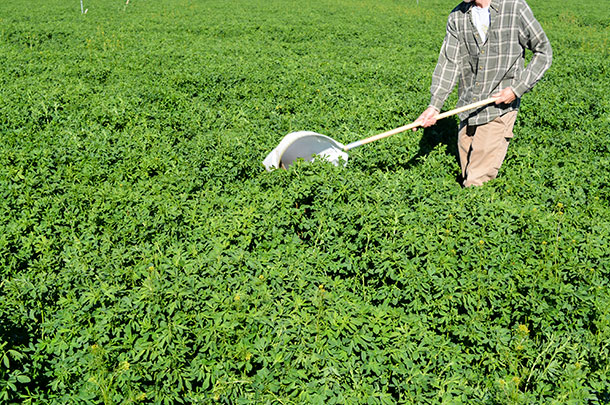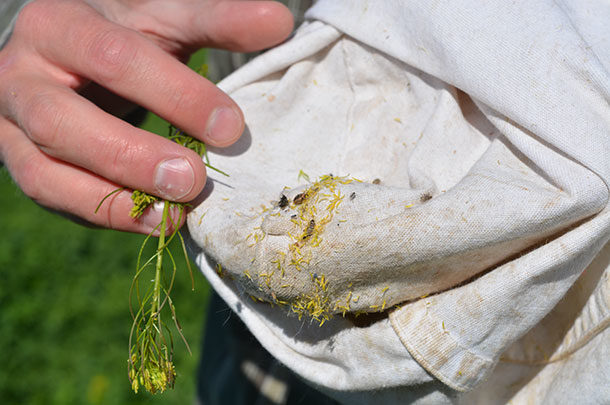I am a strong proponent for integrated pest management (IPM) because it is the most effective and usually more economical strategy.
Proper implementation of IPM requires timely scouting, proper identification of pests and beneficial species, awareness of economic thresholds and use of control methods that minimize damage to desirable and nontarget species.
Alfalfa weevil may be the first insect pest to appear in early spring. A common recommendation is to cut or spray when 40 percent of terminal buds show chewing damage.
Most thresholds are established based on sweep net data, so invest in one just as you would a soil probe for soil sampling. The standard sweep net is 15 inches in diameter with a 26-inch handle. The net should be swung in a 180-degree arc, such that the net rim strikes the top 6 inches of alfalfa growth. Sweep right to left, take a step and take a second sweep from left to right. Repeat until the desired number of sweeps is taken for the pest management guide you are using. After the last sweep, quickly pull up the net to force the insects into the bottom of the net bag and grasp the net bag about half way up. Slowly invert the bag to count insects. Some slow-moving insects, such as caterpillar larvae, can be emptied into a white bucket to be counted. Large numbers of active insects may require chilling the entire net bag to count highly active insects.

Before you decide to spray, consider these points:
- If you can see insect damage from your pickup, you are at least two weeks late in scouting for problems.
- If you start spraying early in the season, you will probably need to continue throughout the season because you likely have taken out many of the beneficial insects that help reduce population surges of damaging insects.
- Insect damage on alfalfa seedlings can reduce the stand for its life, so pay close attention to new stands.
- It is usually best to cut hay early then monitor for resurgence of insect pests than to treat with an insecticide and wait for the preharvest interval.
- An IPM strategy will optimize economic returns in alfalfa.
- The more you use a specific insecticide, the less effective it may become because these applications can select for insects with resistant qualities to those insecticides.
- Check extension information sources. Just because a crop adviser wants you to spray, it doesn’t mean it is economical. For example, there is no evidence that pesticide application for western flower thrips is warranted, despite the leaf distortion they cause.
Pest resurgence after treatment is a common problem. I first experienced pea aphid resurgence after spraying first-cutting alfalfa in the 1970s. We had to spray several times that summer, and thus decided that we would think hard about spraying for pea aphid. Fortunately, plant breeders developed varieties with more resistance to pea aphid, which solved the problem in most cases. Breeding alfalfa varieties with resistance to potato leafhopper is another success story, although resistance is only relatively good compared to susceptible varieties.
Pesticides may be needed if other control measures do not keep populations under the economic thresholds. It is important that the proper chemical is used to target the proper insect and stage of development, and the pesticide is registered for that use in your area. Pesticide registrations change frequently, so you must follow the label and beware of “internet solutions.” Most state extension services have web resources with reliable information. Industry representatives and websites are also excellent resources of information. Beware of “spray and pray” salesmen who think there is a silver bullet for every problem.
We must be good stewards of the technology for pest management, or it will become rapidly ineffective or illegal to use. Think of the long-term effect of applying pesticides. The most practical and economic strategy may be to cut early and monitor closely after harvest. ![]()
Glenn Shewmaker is an extension forage specialist with the University of Idaho. Email Glenn Shewmaker.
References omitted but are available upon request. Click here to email an editor.
PHOTO 1: Using the proper sweep technique should net a variety of bugs. Identifying harmful pests will help determine specific spray treatments to prevent eliminating helpful bugs.
PHOTO 2: University of Idaho entomologist Erik Wenninger demonstrates proper sweep net technique in alfalfa. Photos by Glenn Shewmaker.
Steps of an integrated pest management strategy
- Select varieties of alfalfa that are resistant to your insect pests.
- Scout early. Get into several areas of each field and look closely for feeding damage, developing insect populations and presence of predatory insects.
- Insect identification is a key to management, especially when determining immature stages. For example, pea aphids and blue alfalfa aphids are easily confused; however, blue alfalfa aphids do significantly more damage than pea aphids. Pea aphids generally don’t require control, but blue alfalfa aphids do.
- Consider cultural practices that will reduce insect damage. Can you change cutting schedules to get ahead of insect populations? Can you use strip cutting, grazing, biological controls or judicious use of pesticides along a border?
- Check the label on the pesticide. Can you meet the preharvest interval? Pesticide labels refer to a preharvest interval (PHI), which is the same thing as days to harvest, or the period of time after the application of a pesticide to a crop during which harvest of that crop is prohibited. This is necessary to ensure that the crop will meet the established pesticide residue tolerances. These tolerances may be tested in milk.








